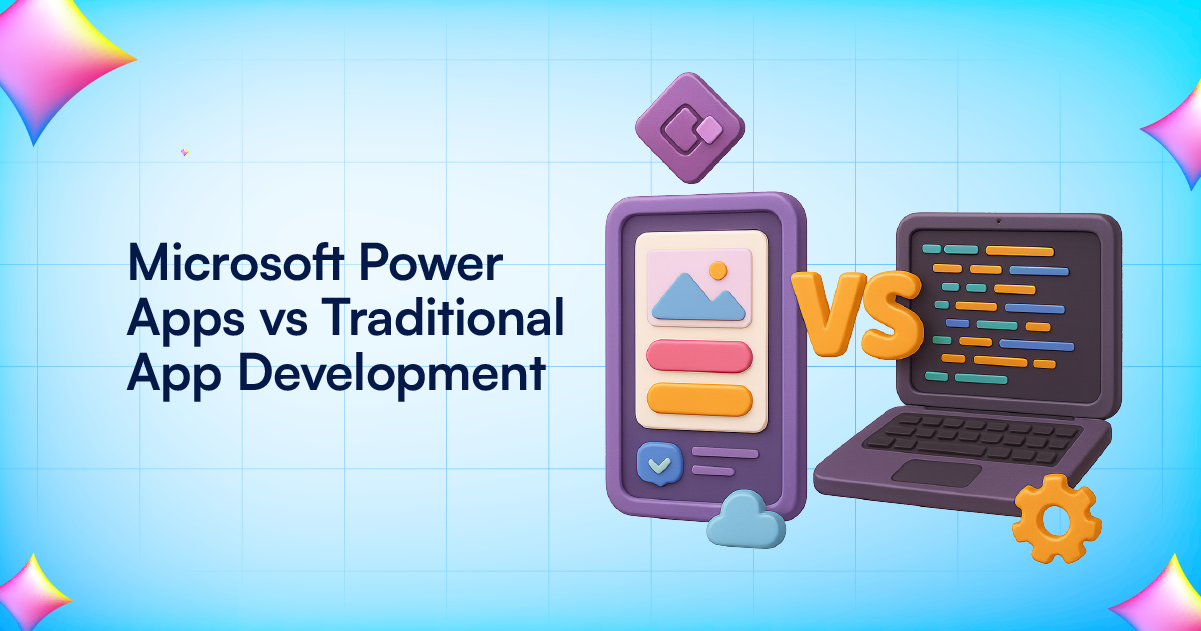
In today’s fast-paced digital landscape, businesses are increasingly relying on technology to stay ahead of the competition. One of the most significant decisions companies face is choosing the right approach for building applications. With the rise of low-code platforms, Microsoft Power Apps has emerged as a strong contender to traditional app development. But how do these two compare? Let’s explore the advantages and disadvantages of Microsoft Power Apps versus traditional app development to help you make an informed decision.
What is Microsoft Power Apps?
Microsoft Power Apps is a powerful low-code application development platform that enables users to create custom applications without writing complex code. It allows businesses to build apps quickly by leveraging pre-built templates, drag-and-drop functionality, and easy integration with other Microsoft services like Power BI, Office 365, and SharePoint. The platform aims to make app development accessible to non-developers while also providing flexibility for experienced developers.
To learn more about Microsoft Power Apps and its capabilities, you can check out Microsoft Power Apps.
What is Traditional App Development?
Traditional app development refers to the custom development of applications using programming languages such as Java, Swift, Kotlin, or C#. This approach often involves a dedicated development team, including project managers, developers, UI/UX designers, and quality assurance specialists. Traditional app development is typically more time-consuming and requires a higher level of technical expertise. However, it offers more control over the app’s architecture, features, and performance.
Key Differences Between Microsoft Power Apps and Traditional App Development
1. Development Speed
One of the most notable differences between Microsoft Power Apps and traditional app development is the development speed.
- Microsoft Power Apps: With its drag-and-drop interface and pre-built templates, Power Apps significantly reduces the time required to build an app. Users can quickly assemble apps without writing extensive code, making it an excellent choice for businesses with limited development resources or tight deadlines. Whether you’re building a mobile app or a web application, the development cycle can be completed in a matter of days or weeks.
- Traditional App Development: Traditional development, on the other hand, is more time-consuming. It involves detailed coding, debugging, and testing, which can take months or even years to complete depending on the complexity of the app. Additionally, traditional app development requires significant coordination between different teams to ensure that the app functions as expected.
2. Cost Efficiency
- Microsoft Power Apps: The low-code nature of Microsoft Power Apps makes it more affordable compared to traditional development. Since the platform enables users to create apps without extensive coding, businesses can save on development costs, reducing the need for large development teams. Moreover, the cost of using Power Apps is subscription-based, which makes budgeting more predictable.
- Traditional App Development: The cost of traditional app development is often higher due to the need for specialized developers, designers, and other experts. Moreover, the development process can be longer, leading to higher costs in terms of time, resources, and ongoing maintenance.
3. Flexibility and Customization
- Microsoft Power Apps: While Power Apps provides a high level of flexibility with its low-code tools, there are limitations in terms of customization. You are confined to the features and templates offered by the platform, which might not suit businesses with highly specific or complex requirements. However, Power Apps does offer some flexibility through integrations and custom code.
- Traditional App Development: Traditional app development provides complete control over every aspect of the application, allowing for highly customized solutions. Developers can tailor the app to meet the exact needs of the business, making this approach ideal for businesses with unique requirements or those looking to build highly complex applications.
4. Scalability
- Microsoft Power Apps: Power Apps is generally best suited for small to medium-sized applications or enterprise-level solutions with minimal complexity. While it does provide scalability, it may not be the best option for highly complex applications that require advanced functionality or handling large amounts of data and users.
- Traditional App Development: Traditional app development offers superior scalability. With custom-built apps, businesses have the flexibility to scale the application as needed, adding new features, expanding infrastructure, or supporting larger user bases. This makes traditional development the go-to solution for large-scale applications or apps requiring extensive backend systems.
5. Maintenance and Updates
- Microsoft Power Apps: One of the key advantages of Power Apps is its simplicity in maintaining and updating applications. Since the platform is built by Microsoft, regular updates and improvements are automatically rolled out, ensuring that the app remains up-to-date with the latest features and security patches.
- Traditional App Development: In traditional app development, maintenance and updates are typically more labor-intensive. Any changes or improvements require manual intervention, which could involve additional development work. This could result in longer downtimes and increased operational costs over time.
6. Integration with Other Systems
- Microsoft Power Apps: Microsoft Power Apps excels in its ability to integrate seamlessly with other Microsoft products like SharePoint, Office 365, and Dynamics 365. This makes it an ideal choice for businesses that already rely heavily on Microsoft services. It also supports integration with third-party apps via connectors, allowing businesses to expand the functionality of their apps.
- Traditional App Development: Traditional app development offers greater flexibility in terms of integration. Developers can build custom APIs to integrate the app with any system, database, or service. While this is more resource-intensive, it provides businesses with the ability to create highly tailored integrations.
Which Is Better for Your Business?
Choosing between Microsoft Power Apps and traditional app development depends on your business’s needs, resources, and objectives.
- Choose Microsoft Power Apps if:
- You need to quickly build and deploy a simple app with minimal development resources.
- You are looking for a cost-effective solution for small to medium-sized projects.
- You rely heavily on Microsoft 365 and other Microsoft tools and need seamless integration.
- Choose Traditional App Development if:
- You require a highly customized, scalable solution for a complex business process.
- You are building a large-scale application or need to handle large amounts of data and users.
- Your business demands more control over the app’s architecture and features.
Both approaches have their strengths, and the right choice will depend on your specific goals and requirements. For businesses already using Microsoft tools, Power Apps offers a streamlined, cost-effective solution. However, for more complex projects, traditional app development provides the flexibility and scalability needed for growth.
To learn more about how Microsoft 365 services can support your business, explore Microsoft Power Apps.
Conclusion
In the debate of Microsoft Power Apps vs traditional app development, there is no one-size-fits-all solution. While Power Apps is an excellent choice for rapid application development with a focus on integration and cost-efficiency, traditional app development remains the go-to option for businesses with complex requirements and the need for high customization. By understanding the strengths and limitations of both approaches, businesses can select the platform that best aligns with their strategic goals.
